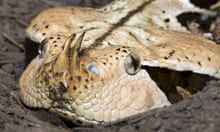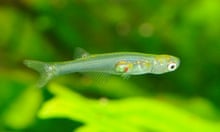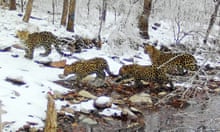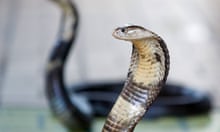It’s been named Fluffy, but its spiky appearance and “nasty bite” means only the brave – or the foolish – would attempt to offer this particular turtle a cuddle.
The dinosaur-like creature, an alligator snapping turtle that can cut bones and is native to swamps and rivers in southern parts of the US, was rescued from a tarn in Cumbria on Monday.
A local dog walker had spotted the exotic creature bathing in the shallow waters of Urswick Tarn, a small lake near Ulverston, and asked others for help identifying it on Facebook.
Denise Chamberlain, an Urswick parish councillor who keeps tortoises and previously spent a couple of years living in the southern US state of Florida, was alerted to the social media post by a friend and instantly recognised the distinctive carnivorous species.
“I looked at it and immediately thought: oh goodness, I know what you are,” said Chamberlain. “I have seen snapping turtles in the wild, but on a much bigger scale. They grow to about 14 stone – and they can snap fingers.”
Despite only being a juvenile, this snapping turtle could still give someone a “nasty nip”, she said. “These turtles have a natural defence mechanism: when you go near them, they open their mouth.”
While snapping turtles are not illegal to own as pets in this country, they are expensive and difficult to care for, so it is possible that Fluffy was dumped in the tarn by a former owner.
After an initial reconnaissance mission to the lake, to check she had identified the reptile correctly, Chamberlain made a few calls to try to organise a rescue effort. “These species are invasive, they’re non-native and I knew it was going to upset the ecology of the tarn, which is very finely balanced.”
The turtles have no natural predators, can grow to about 80cm and live for up to 70 years. They are also found in South and Central America, and have powerful jaws capable of breaking through bone. “That type of creature, while it’s not going to breed, could do some real damage to the fish stocks and eat all sorts of local wildlife,” said Chamberlain.
Chamberlain’s efforts to get help proved fruitless so, although she had never handled anything like it before, she decided to rescue the turtle herself.
She filled a plastic container with water from the tarn, grabbed a plastic shopping basket, put on some “safety gloves” and entered the muddy water up to her calves.
The turtle, she said, was “just sat in the shadows”, looking angry, with only its nose above the waterline. “It was lurking around the top so it could catch the rays of the sun, but stay underwater and breathe.” She added: “It looked like a prehistoric little dinosaur.”
As she came closer, it opened her mouth to show her its strong, beak-like jaw. “Fortunately, because it was quite cold and the turtle itself was quite cold, it wasn’t too difficult to manoeuvre into the shopping basket.”
After “very carefully” giving the reptile a once-over at home to check it wasn’t hurt, Chamberlain fed it some raw chicken and then took it to Wild Side Vets in Barrow-in-Furness.
Dr Kate Hornby, the owner of the clinic and a veterinarian, initially thought it would be a terrapin and was surprised to learn it was an alligator snapping turtle.
after newsletter promotion
“It’s certainly the first one we’ve seen at the clinic – they are kept in the UK but they’re certainly not a common thing you would see at the vets,” the vet told PA Media.
“It would certainly give you a nasty nip and it could probably do significant damage to a finger or finger end, but at this size, it’s not particularly dangerous,” she said.
She said the alligator snapping turtle will be relocated to a specialist reptile centre on Monday where it will be put in warmer waters to speed up its metabolism.
She suspected it had been kept as a pet and the owners had struggled to keep up with its care demands or not wanted it any more.
“We don’t often see reptiles at the clinic, and when they do come in, it’s often because the way they have been kept is incorrect,” she said.
“Doing a lot of research into the particular species you’re looking at keeping and making sure you’ve got the appropriate housing and appropriate knowledge is important.”
She estimated the turtle is about five or six years old: “We haven’t been able to identify whether it’s male or female due to its size – but we’re calling it Fluffy for now.”
Chamberlain said: “I think the name Fluffy is very appropriate – it’s a reference to the creature in Harry Potter. And as someone on Facebook said, it certainly looks like a creature Hagrid would love.”







